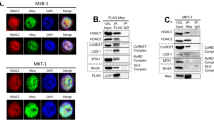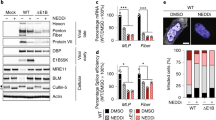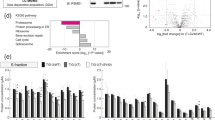Abstract
Adenovirus early region 1A (Ad E1A) is a multifunctional protein which is essential for adenovirus-mediated transformation and oncogenesis. Whilst E1A is generally considered to exert its influence on recipient cells through regulation of transcription it also increases the level of cellular p53 by increasing the protein half-life. With this in view, we have investigated the relationship of Ad E1A to the proteasome, which is normally responsible for degradation of p53. Here we have shown that both Ad5 and Ad12 E1A 12S and 13S proteins can be co-immunoprecipitated with proteasomes and that the larger Ad12 E1A protein binds strongly to at least three components of the 26S but not 20S proteasome. One of these interacting species has been identified as mammalian SUG1, a proteasome regulatory component which also plays a role in the cell as a mediator of transcription. In vitro assays have demonstrated a direct interaction between Ad12 E1A 13S protein and mouse SUG1. Following infection of human cells with Ad5 wt and Ad5 mutants with lesions in the E1A gene it has been shown that human SUG1 can be co-immunoprecipitated with full-length E1A and with E1A carrying a deletion in conserved region 1 which is the region considered to be responsible for increased expression of p53. We have concluded therefore that Ad E1A binds strongly to SUG1 but that this interaction is not responsible for inhibition of proteasome activity. This is consistent with the observation that purified Ad12 E1A inhibits the activity of the purified 20S but not 26S proteasomes. We have also demonstrated that SUG1 can be co-immunoprecipitated with SV40 T and therefore we suggest that this may represent a common interaction of transforming proteins of DNA tumour viruses.
This is a preview of subscription content, access via your institution
Access options
Subscribe to this journal
Receive 50 print issues and online access
$259.00 per year
only $5.18 per issue
Buy this article
- Purchase on Springer Link
- Instant access to full article PDF
Prices may be subject to local taxes which are calculated during checkout









Similar content being viewed by others
References
Bayley ST and Mymryk JS. . 1994 Int. J. Oncol. 5: 425–444.
Berezutskaya E and Bagchi S. . 1997 J. Biol. Chem. 272: 30135–30140.
Boulanger PA and Blair GE. . 1991 Biochem. J. 281: 281–299.
Boyd JM, Subramanian T, Schaefer U, La Regina M, Bayley S and Chinnadurai G. . 1993 EMBO J. 12: 469–478.
Braithwaite AW, Cheetham BF, Li P, Parish CR, Waldron-Stevens LK and Bellet AJD. . 1985 J. Virol. 45: 192–199.
Ciechanover A, Shkedy D, Oren M and Bercovich D. . 1994 J. Biol. Chem. 269: 9582–9589.
Chiou S-K and White E. . 1997 J. Virol. 71: 3515–3525.
Coux O, Tanaka K and Goldberg AL. . 1996 Annu. Rev. Biochem. 65: 801–847.
Debbas M and White E. . 1993 Genes Dev. 7: 546–554.
Fanning E and Knippers R. . 1992 Annu. Rev. Biochem. 61: 55–85.
Fraser RA, Rossignol M, Heard DJ, Egly JM and Chambon P. . 1997 J. Biol. Chem. 272: 7122–7126.
Gallimore PH, Byrd PJ, Whittaker JL and Grand RJA. . 1985 Cancer Res. 45: 2670–2680.
Geisberg JV, Lee WS, Berk AJ and Ricciardi RP. . 1994 Proc. Natl. Acad. Sci. USA 91: 2488–2492.
Grand RJA and Gallimore PH. . 1984 J. Gen. Virol. 65: 2149–2166.
Grand RJA, Grant ML and Gallimore PH. . 1994 Virology 203: 229–240.
Grand RJA, Lecane PS, Roberts S, Grant ML, Lane DP, Young LS, Dawson CW and Gallimore PH. . 1993 Virology 193: 579–591.
Grand RJA, Owen D, Rookes SM and Gallimore PH. . 1996 Virology 218: 23–34.
Grand RJA, Ibrahim AP, Taylor AMR, Milner AE, Gregory CD, Gallimore PH and Turnell AS. . 1998a Virology 244: 330–342.
Grand RJA, Gash L, Milner AE, Molloy DP, Szestak T, Turnell AS and Gallimore PH. . 1998b Virology 244: 230–242.
Harlow E, Franza BR and Schley C. . 1985 J. Virol. 55: 533–546.
Horikoshi N, Maguire KJ, Kralli A, Maldonado E, Reinberg D and Weinmann R. . 1991 Proc. Natl. Acad. Sci. USA 88: 5124–5128.
Jones N. . 1995 Curr. Topics Microbiol. Immunol. 199: 59–80.
Kristensen P, Johnsen AH, Uerkvitz W, Tanaka K and Hendil KB. . 1994 Biochem. Biophys. Res. Comm. 205: 1785–1789.
Lee JW, Ryan F, Swaffield JC, Johnstone SA and Moore DD. . 1995 Nature 374: 91–94.
Lee WS, Kao CC, Bryant GO, Liu X and Berk AJ. . 1991 Cell 67: 365–376.
Lowe SW and Ruley HE. . 1993 Genes Dev. 7: 535–545.
Maruyama K, Schiavi SC, Huse W, Johnson GL and Ruley HE. . 1987 Oncogene 1: 361–367.
Mason GGF, Murray RZ, Pappin D and Rivett AJ. . 1998 FEBS Lett. (in the press).
Moran E. . 1994 Seminars in Virol. 5: 327–340.
Moran E and Mathews MB. . 1987 Cell 48: 177–178.
Mymrk JS and Bayley ST. . 1993 J. Gen. Virol. 74: 2131–2141.
Ohana B, Moore PA, Ruben SM, Southgate CD, Green MR and Rosen CA. . 1993 Proc. Natl. Acad. Sci. USA 90: 138–142.
Querido E, Teodoro JG and Branton PE. . 1997 J. Virol. 71: 3526–3533.
Quinlan MP and Grodzicker T. . 1987 J. Virol. 61: 673–682.
Paraskeva C, Brown KW and Gallimore PH. . 1982 J. Gen. Virol. 58: 73–81.
Peters JM, Franke WW and Kleinschmidt JA. . 1994 J. Biol. Chem. 269: 7709–7718.
Rao L, Debbas M, Sabbatini P, Hockenberry D, Korsmeyer S and White E. . 1992 Proc. Natl. Acad. Sci. USA 89: 7742–7746.
Reidlinger J, Pike AM, Savoury PJ, Murray RZ and Rivett AJ. . 1997 J. Biol. Chem. 272: 24899–24905.
Rivett AJ and Sweeney ST. . 1991 Biochem. J. 278: 171–178.
Rivett AJ. . 1993 Biochem. J. 291: 1–10.
Rivett AJ, Savory PJ and Djaballah H. . 1994 Meth. Enzymol. 244: 331–350.
Rousset R, Desbois C, Bantignies F and Jallinot P. . 1996 Nature 381: 328–331.
Rubin DM, Coux O, Wefes I, Hengartner C, Young RA, Goldberg AL and Finley D. . 1996 Nature 379: 655–657.
Scheffner M, Werness BA, Huibregtse JM, Levine AJ and Howley PM. . 1990 Cell 63: 1129–1136.
Seeger M, Ferrell K, Frank R and Dubiel W. . 1997 J. Biol. Chem. 272: 8145–8148.
Swaffield JC, Melcher K and Johnston SA. . 1995 Nature 374: 88–91.
Varshavsky A. . 1997 Trends Biochem. Sci. 22: 383–387.
vom Baur E, Heery D, Heine MJS, Garnier JM, Vivat V, Le Douarin B, Gronemeyer H, Chambon P and Losson R. . 1995 EMBO J. 15: 110–124.
Wang W, Chevray PM and Nathans D. . 1996 Proc. Natl. Acad. Sci. USA 93: 8236–8240.
Webster KA, Muscat GEO and Kedes L. . 1988 Nature 332: 553–557.
Whyte P, Williamson NM and Harlow E. . 1989 Cell 58: 67–75.
Williams J, Williams M, Liu C and Telling G. . 1995 Curr. Topics Microbiol. Immunol. 199: 149–175.
Zantema A, Shriver PI, Davis-Olivier A, van Laar T, Vaessen RTMJ and van der Eb AJ. . 1985 Mol. Cell. Biol. 5: 3084–3091.
Acknowledgements
We are grateful to Jutta Reidlinger and Rachael Murray (Department of Biochemistry, University of Bristol) for provision of purified proteasomes and Dr Sally Roberts (Institute for Cancer Studies, University of Birmingham) for provision of HPV1 E4-GST fusion protein and antibodies against HPV1 E4. We thank Nicola Waldron for excellent secretarial assistance and Susan Williams for photography. This work was funded by the Cancer Research Campaign, the Lister Institute and the Wellcome Trust. PHG is a Cancer Research Campaign Gibb Fellow.
Author information
Authors and Affiliations
Rights and permissions
About this article
Cite this article
Grand, R., Turnell, A., Mason, G. et al. Adenovirus early region 1A protein binds to mammalian SUG1-a regulatory component of the proteasome. Oncogene 18, 449–458 (1999). https://doi.org/10.1038/sj.onc.1202304
Received:
Revised:
Accepted:
Published:
Issue Date:
DOI: https://doi.org/10.1038/sj.onc.1202304
Keywords
This article is cited by
-
Rpt6
AfCS-Nature Molecule Pages (2007)
-
Roles for APIS and the 20S proteasome in adenovirus E1A-dependent transcription
The EMBO Journal (2006)



